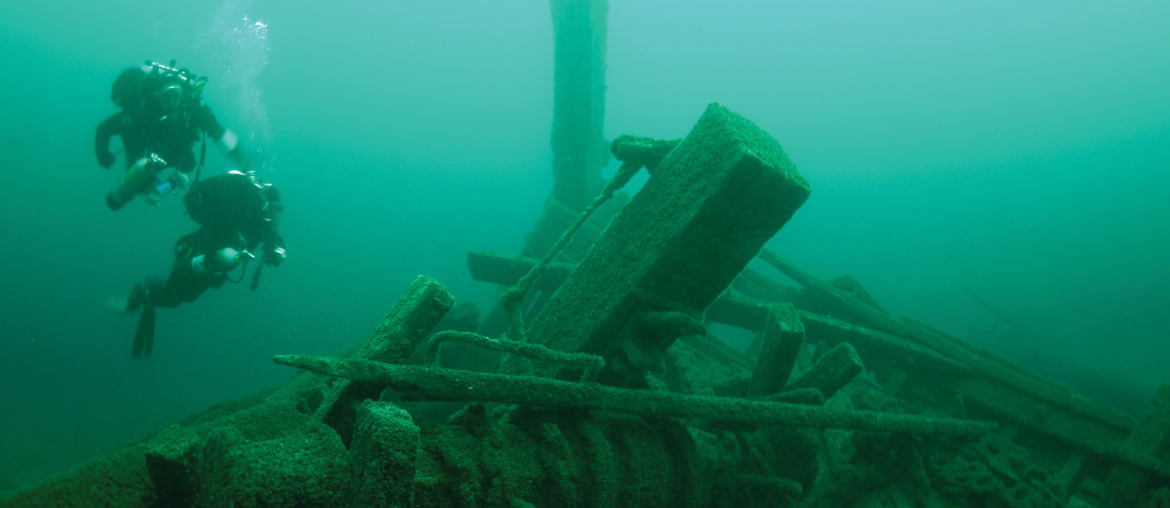By Kevin Revolinski | Photos courtesy of Travel Wisconsin
A boatload of Christmas trees, a violent Lake Michigan storm and a story that lives on. On November 23, 1912, the Rouse Simmons went down with 16 men on board and a cargo of thousands of evergreens, and so became forever known as the Christmas Tree Ship. One of the best known Lake Michigan sailing tragedies, the 124-foot 1868 schooner is now also part of the newly designated Wisconsin Shipwreck Coast National Marine Sanctuary.
The sanctuary, co-managed by the National Oceanic and Atmospheric Association and the State of Wisconsin, covers 962 square miles in Lake Michigan, from just south of Port Washington to about 10 miles north of Two Rivers. Within those cold waters lie 36 shipwrecks — that we know about. The current sanctuary map lists another 23 that are likely down there somewhere, based on historical records. The cold water preserves the ships so that some of them look as if they sank only in recent years. The oldest is the 1833 Gallinipper, a 95- foot schooner that went down in 210 feet of water in 1851.
EXPERIENCING THE SANCTUARY
Signs and displays along lakeside roads commemorate some of the ships: A marker for the Rouse Simmons stands in a shaded spot along Nashotah Beach in Two Rivers. The remains of the 130-foot schooner Lottie Cooper, sunk in 1894, have been brought up and reassembled in the open air in Deland Park near the Sheboygan harbor. The Sheboygan County Historical Society & Museum also has an exhibit about the Cooper and the steamer Phoenix, which took 190 souls with it in 1847, only two years after launching.
In Two Rivers, six historic buildings comprise Rogers Street Fishing Village and Great Lakes Coast Guard Museum. Along with an 1886 lighthouse you can see the Gallinipper’s foremast as well as artifacts from the Rouse Simmons and the Vernon, an 1887 wreck.
Just south in Manitowoc is the Wisconsin Maritime Museum. In addition to fascinating exhibits on shipbuilding and a WWII submarine you can walk through, the museum offers a special interactive exhibit with artifacts relating to sanctuary shipwrecks.
WRECK DIVING
But you can also visit the shipwrecks themselves. NOAA is in the process of marking wrecks with buoys. In early 2022, Port Washington native Matt Savatski co-founded Great Lakes Diving Center, a scuba charter in Sheboygan. Savatski says interest in Great Lakes shipwrecks “is growing on the global stage” even with divers outside the U.S. “This is one of the only places in the world where you still get the old wood wrecks that are still intact.”
Open Water certified recreational divers can visit wrecks as deep as 60 feet or up to 130 feet with an Advanced Open Water certification. Anything deeper, such as the Pringle or the Christmas Tree Ship, requires technical certification. Water gets down to 40-50 degrees at depth, so a dry suit is necessary. “The shallower they are, the more they’ve been beaten by weather and pulled apart,” says Savatski. At 130 feet, the wreck of the 1851 schooner Northerner is perfectly intact, he says.
But if you’re not a diver, there are scattered wrecks near Manitowoc one can see while snorkeling or kayaking, such as the 1881 tugboat Arctic and the 1889 Francis Hinton that lie in about 15 feet of water a few hundred feet from shore.
The details and story of each ship and its unfortunate end can be found at wisconsinshipwrecks.org.






Comments are closed.